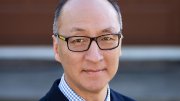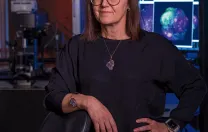Bioethicist Insoo Hyun has spent a lot of time thinking about brain organoids over the past several years. A frequent collaborator of Paola Arlotta’s, he is one of the people whom researchers like her call when they need help teasing apart the ethical and philosophical riddles that come up in their work. Those riddles, he says, are not always what one might expect.
Much of the concern about organoids has focused on the idea of consciousness, the worry that as the tissues grow more complex and sophisticated—closer to the human brains they’re built to mimic—they might become sentient and self-aware, or begin to feel pain. That fixation makes sense, Hyun says: “In the early days of brain organoid research, there was a great temptation among bioethicists, especially those trained in philosophy, to zero in on the consciousness question.” Schooled for years in phenomenology and brain-in-a-vat hypotheticals, “they were already primed to be looking for that narrative,” says Hyun, a member of the Center for Bioethics at Harvard Medical School (and its former director of research ethics), who now leads the Center for Life Sciences and Public Learning at Boston’s Museum of Science. He studied philosophy at Stanford and Brown.
But the consciousness question is not yet a main concern, he says. “The science simply does not support the assumptions that lead up to it.” Organoids remain smaller and simpler than the real thing. They don’t form all the complex neural structures, and they lack the external inputs that help shape a living brain. “Physiologically, they’re just not there yet.”
Hyun instead focuses on more immediate concerns: informed consent of stem-cell donors, appropriate use of organoids, and the ability to validate their accuracy as brain models. These are problems, he says, that “philosophers sitting in their armchairs wouldn’t necessarily come up with.” They arise from the everyday churn of laboratory science, and on-the-ground conversations with researchers. Less sensational-sounding than the prospect of emerging consciousness, these issues are no less deep and thorny. Consider informed consent: “When people participate in research by providing their own biomaterials, all of those samples have to be given under a free and voluntary choice, and with an awareness of what exactly they’re being asked to take part in,” he says. “You don’t want any kind of medical regret here from people who, if they zoomed out and saw the big picture of what they’re enabling with a piece of themselves, they’d wish they hadn’t done it.”
But it can be challenging to get that big-picture awareness across, especially in a field as fast-moving as organoids research. The work is so new. Some of the stem-cell lines currently in use were derived years ago, before brain organoids even existed. How can scientists discuss the possibilities with potential donors in a way that is adequately informative, given that it can’t be absolutely comprehensive? “This is not just a matter of following the regulatory rules and checking all the boxes,” Hyun says. “There’s a deep philosophical moral value underlying this need for proper informed consent.”
“Incidental findings” present another potential ethical conundrum. It’s not unusual for scientists doing research on medical data to discover an abnormality unrelated to the study but relevant to the patient’s health: a genetic screening that reveals a cancer-causing gene, a brain scan that shows the location of an aneurysm. “Something that the researchers weren’t looking for, but that the person who gave the specimen would probably want to know,” Hyun says. In biomedical research, there are guidelines for handling these kinds of discoveries. In most cases, researchers report the incidental findings to the patient’s doctor, who can then inform the patient.
But organoids present an odd twist on the situation. Researchers culturing a clump of neural tissue may discover an unexpected abnormality in the way it develops, which could suggest that in the brain of the original stem-cell donor, something developmentally abnormal happened during gestation. Potentially, this could mean that the donor has a neurological disorder they’re unaware of, or perhaps an increased likelihood of developing a degenerative brain disease in the future. “Should we let them know?” Hyun asks. The answer is not always clear. What if there’s nothing to be done? How certain are the researchers that an idiosyncrasy indicates a problem? “The validity question comes up pretty quickly,” he says. “We don’t want to scare anybody unnecessarily. So, is this just something wrong in my little organoid system, or is it really revealing a truth about this person’s brain? How reliable is this finding?”
The need to validate organoids’ biological accuracy, meanwhile, introduces its own thicket of ethical questions about acceptable data sources and methods for verifying fetal brain tissue. There, too, the question of informed consent comes up. In the end, Hyun says, “The more accurate your model is, the more you have a responsibility, I think, to report back incidental findings.” But this is uncharted ground. “Asking ‘What should I do?’—that’s not a scientific question,” he says. “Right now, it’s not even a legal question, because there’s no law around this. It’s a philosophical moral question: What are my responsibilities? What is the responsibility of the lab, of the institution, if this were to happen?”
Contemplating the limits of appropriate uses for brain organoids brings Hyun back to thinking about consciousness—a concern he sees as distant, but real. The issue is less likely to be the brain-in-a-vat scenario so familiar to philosophy students, in which “an organoid floating in culture media suddenly becomes aware of itself,” he says; more probable would be a complex system that pairs a future organoid with something else to create “maybe not human consciousness, but some form of awareness, some form of experience and sentience.” Perhaps that would mean transplanting an organoid into an animal’s brain, or connecting an organoid to a bioengineered device with input/output capabilities that allow the tissue to interact with the environment. “The good news,” he says, “is that those are engineering decisions we can make along the way. We can develop guardrails and no-go zones.”










